|
Early Adventures with the Automobile
The "horseless carriage" made its debut at Chicago's
Columbian Exposition in 1893. Crude, no more than a two-seated buckboard powered
by an electric motor, none-the-less the exhibit excited its audience. Within
fifteen years the
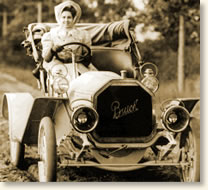 |
Driving a Buick on a country road, 1908
(Notice the right-side steering wheel)
|
automobile
industry was firmly established, producing roomy, comfortable cars capable of
traveling sixty miles per hour. First seen as a toy
for the rich, the car began to be taken more seriously as its advantages over
the horse became obvious, particularly after Henry Ford introduced his Model
T in 1908 (see "Henry Ford Changes the World, 1908").
Driving in these early days was always a challenge. Dirt roads that the horse found perfectly acceptable became impassable quagmires of mud for the automobile. No gas stations dotted the roadscape. As far as navigation was concerned, forget the road map (none existed) and be happy you even have a road to travel.
"My horses took
the arrival of
that automobile
much to heart."
|
Just owning a car could cause trauma. Writing in 1902, a Vermont resident observed: "In my stable, my horses took the arrival of that automobile much to heart, and five of them almost died with some form of distemper the next month. My hostler did almost as much kicking as his four-footed charges. He insisted that he had to hunt for the horses in the hay loft, because they invariably went up the feed spout every time I started the engine in the stable: and when I asked him to wash the automobile, he fainted dead away, and revived only long enough to give his notice of departure."
Despite these challenges, it was not long before the automobile transformed itself from novelty to necessity. Although many would continue to criticize this "new fangled" mode of transportation, one thing was certain: there would be no turning back. The automobile became a fixture of American culture and our infatuation with the car blossomed into a love affair.
In 1904, W.K. Vanderbilt, Jr, established the "Vanderbilt Cup" to promote the sport of automobile racing. The event was originally run on Long Island over public roads. Crowds lined the raceway without benefit of any barriers, often creating hair raising hazards as the big racers whizzed by. Drivers began the race at timed intervals with the first to cross the finish in the fastest time declared the winner. In 1906, Louis Wagner won the race driving a Darracq. He later described his experience:
"Starting in tenth place my time for the first lap, 28:36, enabled me to overtake and pass Nazzaro and Luttgen, then Heath and Le Blon, on the initial circuit, and Shepard at the tape. The leading cars were behaving with wonderful consistency. But the crowd! On rounding the Hairpin Turn for the second time, directly in the road were at least fifty persons as we approached the turn. They swiftly made way, but my car must have brushed at least a dozen coats while taking the turn. I actually shut my eyes and piloted the machine by blind instinct - expecting any moment to mow down several lives. That no one was slain was nothing less than a miracle. For the oil-sodden roadstead, to one traveling faster than a mile a minute, was nothing but a very narrow ribbon fringed at brief intervals with blotches of humanity. As for the eleven sharp bends in the course, it was impossible for me to know from my own vision just when and where they may be met. For this knowledge I depended entirely upon my companion who directed the way with his hand."
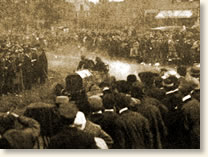 |
Spectators crowd the course of the
1906 Vanderbilt Cup race
|
"As we swung into the stretch leading to the treacherous Bull's Head Turn, and while going fully eighty miles an hour, one of the rear tires struck a broken glass bottle which had been thrown into the road and collapsed with a terrific detonation. My hopes collapsed with the tire. Some two miles farther on was our emergency station and, without slackening speed, though at the imminent risk of disaster, we got there. Every second was a century. Without realizing what I was doing I took a glass of champagne and two raw eggs, while the emergency crew wrestled in a frenzy with the tires."
"It seemed but a fraction of a moment before a vague speck appeared two miles away on the course. It swiftly became a cloud, then a dreaded outline, and with a sudden rush and roar Lancia thundered by and was gone. There was no more stopping or slackening at turns, no further fear or concern over the reckless crowd. A mile from the finish it became evident that the dense mass of spectators was beyond control. Lancia had finished. But how long ago? As in a trance a bugle sounded and the next moment, with a flash and volley, the Darracq was over the tape - a winner."
In 1907, an intrepid group of adventurers drove from New York City to Jamestown, Virginia to attend the Jamestown Exposition. Their journey lasted three days and took them through New York, Pennsylvania, Delaware, Maryland and Virginia. The following is excerpted from an article in Outing Magazine. The author provides insight into the hazards of motoring in the car's early days.
Fixing the inevitable flat tire:
"We had brought
only two spare inners and
the worst of the
journey was yet to
come."
|
"Down went a tire on the off driving-wheel and we were in for a repair. Off
came the cover, a stiff brand-new cover it was too - but the inner tube lay revealed
at last and we set to work to find the puncture. We blew the tube up, filled
it with water even, in our effort to find where the trouble lay and finally discovered
it lurking close to the valve where a patch was out of the question. We had brought
only two spare inners with us and the worst of the journey was yet to come. Grudgingly
we fished one out from its dust-proof receptacle, as men who are drawing a check
against half their earthly possessions and do not know how soon the other half
may have to go too. The precious tube was soon pushed inside the cover with an
all too liberal allowance of French chalk administered by the irrepressible amateur.
It was shaken out in time, however, the tube partially inflated and in a few
moments the beaded edge was safe within the rim, the tire blown up, the wing-bolts
tightened and we were ready for the road again."
Perils of the country road:
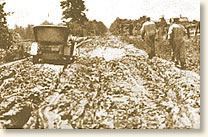 |
Stuck on a country road, 1907
|
"The roads themselves are mostly bad, the surface heavy with lose sand and worn into deep ruts by the farmers' wagons which follow their channels faithfully for miles. To steer clear of these ruts, straggling along as they did in irregular lines, was a task far from easy and one always successfully accomplished with a resulting heavy strain on the distance-rod and knuckles. Moreover, we had forgotten to cover the steering joints with leather and the grit ground into the open joints to such an extent that by the time we reached Cape Charles the wheel had a 'backlash' that five thousand miles of ordinary road would not have given it."
Giving deference to the horse and mule:
"Evidently cars as yet are few and far between in this part of the country, for the honk of our horn brought folks to their doors and horses and mules resented our approach by backing away and performing other antics discreditable to their sagacity. We often stopped in deference to their feelings while the driver made a detour into the fields to avoid us or stood at their heads while, with a maximum of caution and a minimum of gasoline, we slowly passed."
Dr. H. Nelson Jackson was the first to motor coast-to-coast in 1903. Two dozen other pioneers matched his feat over the next five years, but none was a woman. This honor fell to Alice Huyler Ramsey a 22-year-old housewife and mother from Hackensack, New Jersey. On June 9, 1909, Alice, and three women companions (none of whom drove), left Manhattan in her sturdy Maxwell. Fifty-nine days and 3,800 miles later they arrived in San Francisco.
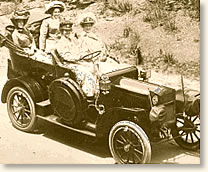 |
Alice Ramsey, her crew (Nettie Powell,
Margaret Atwood and Hermine
James) and her Maxwell
|
"Four miles from Grand Island the rear axle broke again. A farm family took us in while a mechanic from Denver brought another. Nettie was happy to give her place to the mechanic and ride the train ahead to Cheyenne. Near Ogallala, Nebraska, we were halted by a nondescript sheriff's posse on horseback. They were looking for two murderers and at first didn't believe us when we explained that we were only trying to drive from New York to San Francisco. It was not until the lawmen were convinced that no firearms or suspects were concealed in the Maxwell that they allowed us to go on."
"At Fort Steele, Wyoming, we pulled up short at a dead-end in the road where the bridge over the swollen North Platte had been washed out. I sent my passengers ahead on foot across a paralleling Union Pacific railroad trestle and then bumped the Maxwell for three-quarters of a mile on the ties to the opposite side. Across Wyoming the roads threaded through privately owned cattle ranches. My companions were obliged to take turns opening and closing the gates of the fences which surrounded them as we drove through. If we got lost we'd take to the high ground and search the horizon for the nearest telephone poles with the most wires. It was a sure way of locating the transcontinental railroad which we new would lead us back to civilization."
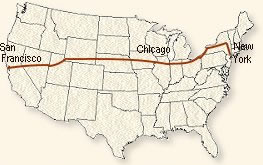 |
Alice Ramsey's route; no roadmaps, few paved
roads, few roads at all west of the Mississippi
|
"In Utah we hit a prairie dog hole in the road with such force that a tie bolt came out of the tie rod connecting the front wheels. Down went the front end, wheels spread-eagled, breaking the spring seat over the front axle. We had a pilot car with us and driver Frank Irving went back to Orr's ranch where they had a forge and we were able to make temporary repairs. In spite of everything, we finally made it across Nevada arriving near midnight at the Riverside Hotel in Reno. Next day we continued by way of Carson City across the Sierras to Placeville, then to Sacramento. Between Stockton and the Oakland Ferry we were lead by an escort of Maxwells."
References:
Coffey, Frank, America On Wheels: the first 100 years, 1896-1996 (1996); Georgano, Nick, The American Automobile: a centenary, 1893-1993 (1992); Ramsey, Alice Huyler, Veil, Duster and Tire Iron (1961); Outing Magazine (1906, 1907).
How To Cite This Article:
"Early Adventures with the Automobile," EyeWitness to History, www.eyewitnesstohistory.com (1997).
|






